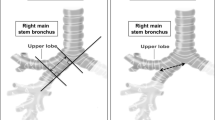Abstract
Objective
The target in the thoracic sympathetic ganglion block (TSGB) is the anterior edge of the costovertebral articulation along the lateral surface of vertebral bodies T2–4. The present study attempts to determine an optimal safe angle for fluoroscopy in fluoroscope-assisted TSGB through the use of chest CT scan images. Additionally, we seek to determine if differences in these measurements exist in patients with chronic obstructive pulmonary disease (COPD).
Methods
Chest CT scans from 320 patients were included. The range of angle and entry point distance to midline was measured in all subjects. The range of angle was from the minimum angle to thoracic sympathetic ganglion passing over the lateral aspect of body to the maximum angle to the thoracic sympathetic ganglion not puncturing the pleural space. Additionally, these measurements from 50 COPD patients were subsequently compared age-matched individuals without COPD.
Results
No significant difference in optimal angle was found for any of the levels between T2 and T4. The optimal angle was significantly different between right and left sides, although no such difference was identified between genders. The older patients had a significantly smaller optimal angle than the younger. Similarly, individuals with COPD had a significantly smaller optimal angle and entry distance.
Interpretation
The measurements derived from this study can be used as a reference for TSGB and radiofrequency lesioning to prevent the complications. Specifically, our data indicate that the optimal oblique angle of fluoroscopy is 18°–19° for non-COPD patients and 16°–17° for COPD patients.



Similar content being viewed by others
References
Wu C, Marsh A, Dworkin R (2000) The role of sympathetic nerve blocks in herpes zoster and postherpetic neuralgia. Pain 87:121–129
Boas R (1998) Sympathetic nerve blocks: in search of a role. Reg Anesth Pain Med 23:292–305
Waldman SD (2001) Thoracic sympathetic ganglion block. In: Waldman SD (ed) Interventional pain management, 2nd edn. WB Saunders, Philadelphia, pp 399–400
Roos D (1977) Sympathectomy for the upper extremities: anatomy, indications and techniques. In: Rutherford R (ed) Vascular surgery. WB Saunders, Philadelphia, pp 623–628
Wilkinson H (1996) Percutaneous radiofrequency upper thoracic sympathectomy. Neurosurgery 38:715–725
Gabrhelik T, Michalek P, Adamus M, Berta E (2009) Percutaneous upper thoracic radiofrequency sympathectomy in Raynaud phenomenon: a comparison of T2/T3 procedure versus T2 lesion with phenol application. Reg Anesth Pain Med 34:425–429
Erdine S, Talu GK (2008) Thoracic sympathetic blocks of the thorax. In: Raj PP (ed) Interventional pain management, 2nd edn. WB Saunders, Philadelphia, pp 255–260
Horma B, Lucas A, Marin F, Duvauferrier R, Rolland Y (2004) Evaluation of the efficacy of CT guided thoracic sympatholysis to treat palmar hyperhidrosis. J Radiol 85:21–24
Stanton-Hicks M (2001) Thoracic sympathetic block: a new approach. Tech Reg Anesth Pain Manag 5:94–98
Atkins J, Butler P (2002) Hyperhidrosis: a review of current management. Plast Reconstr Surg 110:222–228
Munia M, Wolosker N, Kauffman P, de Campos J, Puech-Leao P (2007) A randomized trial of T3–T4 versus T4 sympathectomy for isolated axillary hyperhidrosis. J Vasc Surg 45:130–133
Bellemare F, Cordeau M, Couture J, Lafontaine E, Leblanc P, Passerini L (2002) Effects of emphysema and lung volume reduction surgery on transdiaphragmatic pressure and diaphragm length. Chest 121:1898–1910
National Institutes of Health (NIH), National Heart Lung and Blood Institute (NHLBI), World Health Organiztion (WHO) (2009) Global initiative for chronic obstructive lung disease (GOLD): global strategy for the diagnosis, management, and prevention of chronic obstructive pulmonary disease NHLBI/WHO Workshop Report. (update in 2009) http://www.goldcopd.com. Accessed 10 March 2010
Kim D, Kim Y, Chung K, Chang J, Lim C, Lee J, Uh S, Shim J, Lew W (2005) Prevalence of chronic obstructive pulmonary disease in Korea: a population-based spirometry survey. Am J Respir Crit Care Med 172:842–847
Stanton-Hicks M (2007) Complications of sympathetic blocks for extremity pain. Tech Reg Anesth Pain Manag 11:148–151
Wladman SD (2004) Thoracic sympathetic ganglion block. In: Waldman SD (ed) Atlas of interventional pain management, 2nd edn. WB Saunders, Philadelphia, pp 238–239
Moore KL (1992) The thorax. In: Moore KL (ed) Clinically oriented anatomy, 3rd edn. Williams & Wilkins, Baltimore, pp 65–66
Snodgrass J (2004) Sex differences and aging of the vertebral column. J Forensic Sci 49:458–463
Cvijeti S, McCloskey E, Korsi M (2000) Vertebral osteophytosis and vertebral deformities in an elderly population sample. Wien Klin Wochenschr 112:407–412
Verbeken E, Cauberghs M, Mertens I, Clement J, Lauweryns J, Van de Woestijne K (1992) The senile lung. Comparison with normal and emphysematous lungs. 1. Structural aspects. Chest 101:793–799
Lexell J (1995) Human aging, muscle mass, and fiber type composition. J Gerontol A Biol Sci Med Sci 50:11–16
Lee K, Chuang C, Lin C, Tsai L, Hwang S, Howng S (2004) Percutaneous CT-guided chemical thoracic sympathectomy for patients with palmar hyperhidrosis after transthoracic endoscopic sympathectomy. Surg Neurol 62:501–505
Han K, Kim C, Park E (2008) Successful treatment of digital ulcers in a scleroderma patient with continuous bilateral thoracic sympathetic block. Pain Physician 11:91–96
Author information
Authors and Affiliations
Corresponding author
Rights and permissions
About this article
Cite this article
Kim, W.H., Lee, C.J., Kim, T.H. et al. The optimal oblique angle of fluoroscope for thoracic sympathetic ganglion block. Clin Auton Res 21, 89–96 (2011). https://doi.org/10.1007/s10286-010-0093-3
Received:
Accepted:
Published:
Issue Date:
DOI: https://doi.org/10.1007/s10286-010-0093-3




